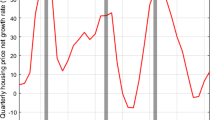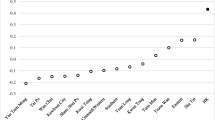Abstract
Frequently migration between Hong Kong (HK) and China can cause the real estate price standards of HK’s and China’s first-tier cities to resemble one another. This study adopts the real estate prices of HK and four major cities in China, namely Beijing, Shanghai, Shenzhen, and Guangzhou, from January 2001 to April 2019. The results reveal that for both long- and short-term returns, the HK real estate market is influenced by the Shanghai real estate market. The HK real estate market and the Shenzhen real estate market exhibit the most connectedness. This may be because of their geographic closeness; people are more likely to migrate between these two cities. The real estate market in Beijing exhibits the greatest informativeness. In the four cities, only the informativeness of Guangzhou City substantially lags behind that of HK. This study also discovers that in the relationship between those regional real estate markets, exchange rate and stock market returns are key factors. The connection between the housing markets of Beijing and Hong Kong is attributable to the foreign exchange market, whereas the connection between the housing markets of Hong Kong and other first-tier cities is attributable to the stock market. The change in exchange rate influences the volatility of Beijing’s real estate market. After this volatility is transmitted to HK, it influences the correlation between HK and Shanghai real estate markets as well as between HK and Shenzhen real estate markets.





Similar content being viewed by others
Notes
The duration of Cheng and Glascock’s (2005) research is from January 1993 to August 2004. Their samples come from the Morgan Stanley Capital International weekly stock market index given in US dollars. Innovation accounting analysis is adopted to observe variance of prediction error, and they discover that only a low percentage of Hong Kong index can be explained by the China index, at most 1.28%.
The study of Huo and Ahmed (2017) was from the period between July 2, 2014 and April 8, 2015. The samples come from the Shanghai Stock Exchange composite index and the Hong Kong Hang Seng Index every minute. The estimation results demonstrate that the stock index of the two places can be predicted by the lagging-period price of itself or the other. After the Shanghai–Hong Kong Stock Connect, Shanghai stock price exerts a significant spillover effect on Hong Kong stock price.
Zhang et al. (2016) point out that the economic structure in China was constantly improved and upgraded, and there have been some new developments in the country's real estate market.
Bodart and Reding (1999) found that that an increase in exchange rate volatility is accompanied by a decline in international correlations between bond and stock markets. Kim et al. (2006) found that real economic integration and the reduction in currency risk have generally had the desired effect of inter-financial market integration.
Figures 3 and 4 present dynamic spillover effects between variables estimated through rolling windows. The spillover index is estimated using variance decomposition based on a generalized VAR model, and thus the length of rolling-sample windows (i.e., the window size) must be determined in consideration of the number of variables and the degree of lag. Numerous variables or a high degree of lag indicates the necessity of a numerous periods (i.e., a large window size) in the estimation. Empirical studies choose their window size according to their sample requirements. For example, Diebold and Yilmaz (2013) determine the length of their rolling-sample windows to be 60 periods, whereas Tsai and Chiang (2019) use 40 periods as their window size. The present study, given the few variables included and to reveal variations in the correlations between different periods, uses a relatively concise model for estimation. This paper estimated total connectedness over 24-month rolling-sample windows.
References
Antonakakis N, Chatziantoniou I, Floros C, Gabauer D (2018) The dynamic connectedness of UK regional property returns. Urban Stud 55(14):3110–3134
Baklaci HF, Aydoğan B, Yelkenci Y (2020) Impact of stock market trading on currency market volatility spillovers. Res Int Bus Finance 52:101182
Bekiros S (2014) Nonlinear causality testing with stepwise multivariate filtering: evidence from stock and currency markets. N Am J Econ Finance 29:336–348
Bodart V, Reding P (1999) Exchange rate regime, volatility and international correlations on bond and stock markets. J Int Money Financ 18(1):133–151
Caporale GM, Hunter J, Ali FM (2014) On the linkages between stock prices and exchange rates: evidence from the banking crisis of 2007–2010. Int Rev Financ Anal 33:87–103
Cheng H, Glascock JL (2005) Dynamic linkages between the greater China economic area stock markets—Mainland China, Hong Kong, and Taiwan. Rev Quant Financ Acc 24(4):343–357
Deng Y, Girardin E, Joyeux R, Shi S (2017) Did bubbles migrate from the stock to the housing market in China between 2005 and 2010? Pac Econ Rev 22(3):276–292
Deng Y, Girardin E, Joyeux R (2018) Fundamentals and the volatility of real estate prices in China: a sequential modelling strategy. China Econ Rev 48:205–222
Diebold FX, Yilmaz K (2013) Measuring the dynamics of global business cycle connectedness. PIER Working Paper No. 13-070. https://ssrn.com/abstract=2369340
Diebold FX, Yilmaz K (2012) Better to give than to receive: predictive directional measurement of volatility spillovers. Int J Forecast 28(1):57–66
Diebold FX, Yilmaz K (2014) On the network topology of variance decompositions: measuring the connectedness of financial firms. J Econom 182(1):119–134
Fan Q, Wang T (2017) The impact of Shanghai-Hong Kong Stock Connect policy on A-H share price premium. Financ Res Lett 21:222–227
Gerlach-Kristen P (2009) Business cycle and inflation synchronisation in Mainland China and Hong Kong. Int Rev Econ Financ 18(3):404–418
Gong Y, Hu J, Boelhouwer PJ (2016) Spatial interrelations of Chinese housing markets: spatial causality, convergence and diffusion. Reg Sci Urban Econ 59:103–117
Gupta R, Miller SM (2012) The time-series properties of house prices: a case study of the southern California market. J Real Estate Financ Econ 44(3):339–361
He Q, Qian Z, Fei Z, Chong TT-L (2019) Do speculative bubbles migrate in the Chinese stock market? Empir Econ 56:735–754
Ho K-Y, Shi Y, Zhang Z (2016) It takes two to tango: A regime-switching analysis of the correlation dynamics between the mainland Chinese and Hong Kong stock markets. Scott J Polit Econ 63(1):41–65
Huang J, Shen GQ (2017) Residential housing bubbles in Hong Kong: identification and explanation based on GSADF test and dynamic probit model. J Prop Res 34(2):108–128
Hui ECM, Ng I (2009) Price discovery of property markets in Shenzhen and Hong Kong. Constr Manag Econ 27(12):1175–1196
Hui ECM, Yu KH (2012) Assisted homeownership, investment and their roles in private property price dynamics in Hong Kong. Habitat Int 36:219–225
Hui ECM, Yue S (2006) Housing price bubbles in Hong Kong, Beijing and Shanghai: a comparative study. J Real Estate Financ Econ 33(4):299–327
Huo R, Ahmed AD (2017) Return and volatility spillovers effects: evaluating the impact of Shanghai-Hong Kong Stock Connect. Econ Model 61:260–272
Kim S-J, Moshirian F, Wu E (2006) Evolution of international stock and bond market integration: influence of the European Monetary Union. J Bank Finance 30(5):1507–1534
Koop G, Pesaran MH, Potter SM (1996) Impulse response analysis in nonlinear multivariate models. J Econom 74(1):119–147
Leung CKY, Tang ECH (2011) Comparing two financial crises the case of Hong Kong real estate markets. In: Bardhan A, Edelstein RH, Kroll CA (eds) Global housing markets: crises, policies, and institutions. Wiley, Hoboken, pp 377–398
Liow KH, Huang Y, Song J (2019) Relationship between the United States housing and stock markets: some evidence from wavelet analysis. N Am J Econ Finance 50:101033
Liu T-Y, Chang H-L, Su C-W, Jiang X-Z (2016) China’s housing bubble burst? Econ Transit 24(2):361–389
Miao H, Ramchander S, Simpson MW (2011) Return and volatility transmission in U.S. housing markets. Real Estate Econ 39(4):701–741
Monkkonen P, Wong K, Begley J (2012) Economic restructuring, urban growth, and short-term trading: the spatial dynamics of the Hong Kong housing market, 1992–2008. Reg Sci Urban Econ 42:396–406
Pan W (2019) Detecting bubbles in China’s regional housing markets. Empir Econ 56:1413–1432
Pesaran HH, Shin Y (1998) Generalized impulse response analysis in linear multivariate models. Econ Lett 58(1):17–29
Phillips PCB, Yu J (2011) Dating the timeline of financial bubbles during the subprime crisis. Quant Econ 2(3):455–491
Shen Y-Y, Jiang Z-Q, Ma J-C, Wang G-J, Zhou W-X (2021) Sector connectedness in the Chinese stock markets. Empir Econ. https://doi.org/10.1007/s00181-021-02036-0
Tsai I-C, Chiang S-H (2019) Exuberance and spillovers in housing markets: evidence from first- and second-tier cities in China. Reg Sci Urban Econ 77:75–86
Xiao Q, Liu Y (2010) The residential market of Hong Kong: rational or irrational? Appl Econ 42(7):923–933
Yang X, Zhang Y, Li Q (2021) The role of price spillovers: what is different in China. Empir Econ 60:459–485
Yiu MS, Yu J, Jin L (2013) Detecting bubbles in Hong Kong residential property market. J Asian Econ 28:115–124
Zhang H, Li L, Chen T, Li V (2016) Where will China’s real estate market go under the economy’s new normal? Cities 55:42–48
Acknowledgements
I am immensely grateful to Professor Robert M. Kunst (Editor) and the anonymous referee for the constructive comments of this paper.
Funding
Funding from the Ministry of Science and Technology of Taiwan under Project No. MOST 110-2410-H-390-008-MY3 has enabled the continuation of this research and the dissemination of these results.
Author information
Authors and Affiliations
Corresponding author
Ethics declarations
Conflict of interest
The author declares that she has no conflict of interest.
Ethical approval
This article does not contain any studies with human participants or animals performed by any of the authors.
Additional information
Publisher's Note
Springer Nature remains neutral with regard to jurisdictional claims in published maps and institutional affiliations.
Rights and permissions
About this article
Cite this article
Tsai, IC. The connectedness between Hong Kong and China real estate markets: spillover effect and information transmission. Empir Econ 63, 287–311 (2022). https://doi.org/10.1007/s00181-021-02143-y
Received:
Accepted:
Published:
Issue Date:
DOI: https://doi.org/10.1007/s00181-021-02143-y
Keywords
- The HK real estate market
- The China real estate market
- Connectedness
- Spillover effect
- Information transmission




